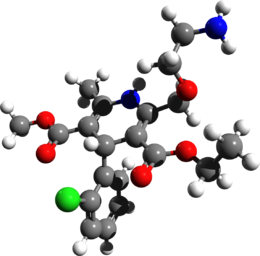- Amlodipine
-
Amlodipine 

Systematic (IUPAC) name (RS)-3-ethyl 5-methyl 2-[(2-aminoethoxy)methyl]-4-(2-chlorophenyl)-6-methyl-1,4-dihydropyridine-3,5-dicarboxylate Clinical data Trade names Norvasc AHFS/Drugs.com monograph MedlinePlus a692044 Licence data US FDA:link Pregnancy cat. C(AU) C(US) Legal status POM (UK) ℞-only (US) Routes Oral (tablets) Pharmacokinetic data Bioavailability 64 to 90% Metabolism Hepatic Half-life 30 to 50 hours Excretion Renal Identifiers CAS number 88150-42-9 
ATC code C08CA01 PubChem CID 2162 DrugBank APRD00520 ChemSpider 2077 
UNII 1J444QC288 
KEGG D07450 
ChEBI CHEBI:2668 
ChEMBL CHEMBL1491 
Chemical data Formula C20H25ClN2O5 Mol. mass 408.879 g/mol SMILES eMolecules & PubChem  (what is this?) (verify)
(what is this?) (verify)Amlodipine (as besylate, mesylate or maleate) is a long-acting calcium channel blocker (dihydropyridine (DHP) class) used as an anti-hypertensive and in the treatment of angina. Like other calcium channel blockers, amlodipine acts by relaxing the smooth muscle in the arterial wall, decreasing total peripheral resistance and hence reducing blood pressure; in angina it increases blood flow to the heart muscle (although DHP-class calcium channel blockers are more selective for arteries than myocardium, as the cardiac calcium channels are not of the dihydropyridine-type).
Contents
Medical uses
Amlodipine is used in the management of hypertension, and coronary artery disease.[1]
Contraindications
- breast feeding
- cardiogenic shock
- unstable angina
- aortic stenosis: amlodipine causes vasodilation, which can result in reduced cardiac output in patients with severe aortic stenosis.
Adverse effects
Adverse side effects of the use of amlodipine may be:[2]
- Very often: peripheral edema in 8.3% of users, fatigue in 4.5% of users[3]
- Often: dizziness; palpitations; muscle-, stomach- or headache; dyspepsia; nausea - in 1 in 100 users
- Sometimes: blood disorders, development of breasts in men (gynecomastia), impotence, depression, insomnia, tachycardia, gingival enlargement - in 1 in 1,000 users,
- Rarely: erratic behavior, hepatitis, jaundice - in 1 in 10,000 users
- Very rarely: hyperglycemia, tremor, Stevens-Johnson syndrome - in 1 in 100,000 users
The acute oral toxicity (LD50) of amlodipine in mice is 37 mg/kg.[4]
Cautions
- hepatic impairment
- pregnancy
Interactions
- In patients with severe coronary artery disease, amlodipine can increase the frequency and severity of angina or actually cause a heart attack on rare occasions. This phenomenon usually occurs when first starting amlodipine, or at the time of dosage increase.[citation needed]
- Excessive lowering of blood pressure during initiation of amlodipine treatment can occur, especially in patients already taking another medication for lowering blood pressure. In rare instances, congestive heart failure has been associated with amlodipine, usually in patients already on a beta blocker.
Mechanism of action
Amlodipine is a dihydropyridine calcium antagonist (calcium ion antagonist or slow-channel blocker) that inhibits the transmembrane influx of calcium ions into vascular smooth muscle and cardiac muscle. Experimental data suggest that amlodipine binds to both dihydropyridine and nondihydropyridine binding sites. The contractile processes of cardiac muscle and vascular smooth muscle are dependent upon the movement of extracellular calcium ions into these cells through specific ion channels. Amlodipine inhibits calcium ion influx across cell membranes selectively, with a greater effect on vascular smooth muscle cells than on cardiac muscle cells. Negative inotropic effects can be detected in vitro but such effects have not been seen in intact animals at therapeutic doses. Serum calcium concentration is not affected by amlodipine. Within the physiologic pH range, amlodipine is an ionized compound (pKa=8.6), and its kinetic interaction with the calcium channel receptor is characterized by a gradual rate of association and dissociation with the receptor binding site, resulting in a gradual onset of effect.
Amlodipine is a peripheral arterial vasodilator that acts directly on vascular smooth muscle to cause a reduction in peripheral vascular resistance and reduction in blood pressure.
The precise mechanisms by which amlodipine relieves angina have not been fully delineated, but are thought to include the following:
- Exertional angina
- In patients with exertional angina, amlodipine reduces the total peripheral resistance (afterload) against which the heart works and reduces the rate pressure product, and thus lowers myocardial oxygen demand, at any given level of exercise.
- Vasospastic angina
- Amlodipine has been demonstrated to block constriction and restore blood flow in coronary arteries and arterioles in response to calcium, potassium epinephrine, serotonin, and thromboxane A2 analog in experimental animal models and in human coronary vessels in vitro. This inhibition of coronary spasm is responsible for the effectiveness of amlodipine in vasospastic (Prinzmetal's or variant) angina.
Pharmacokinetics
Amlodipine is almost entirely metabolised to inactive metabolites. 10% of the parent substance and 60% of the metabolites are excreted in urine.
Stereoisomerism
Amlodipine is a chiral calcium antagonist, currently on the market and in therapeutic use as a racemate [1:1 mixture of (R)-(+)- and (S)-(–)-amlodipine][5] A method for the semi-preparative chromatographic purification of the enantiomers (S)-(–)-amlodipine and (R)-(+)-amlodipine has been reported.[6]
Preparations
Pfizer patent protection on Norvasc lasted until 2007. Total patent expiration occurred later in 2007.[7] A number of generic versions are available.
In the United Kingdom tablets of amlodipine from different suppliers may contain different salts. The strength of the tablets is expressed in terms of amlodipine base, i.e., without the salt. Tablets containing different salts are therefore considered interchangeable.
The efficacy and tolerability of a fixed-dose combination of amlodipine 5 mg and perindopril 4 mg, an angiotensin converting enzyme (ACE) inhibitor, have recently been confirmed in a prospective, observational multicentre trial of 1250 hypertensive patients.[8]
Brand names
Amlodipine is marketed as:
- Amlosun in Bangladesh by Sun Pharmaceutical (Bangladesh) Ltd.
- Nopidin in Bangladesh by Ad-din Pharmaceuticals Ltd.
- Camlodin in Bangladesh by Square Pharmaceuticals Ltd.
- Agen by Zentiva in the Czech Republic
- Aken in Mexico by Kendrick Farmaceutica
- Amcard in Bangladesh by Apex Pharma Ltd
- ATECARD-AM in India by Alembic Ltd
- Amdepin by Cadila Pharmaceuticals in India
- Asomex by Emcure Pharmaceuticals India
- Amdipin in Colombia by Laboratorios Lafrancol
- Amlopin in Lek d.d.
- Amlodine by Dainippon Sumitomo Pharmaceuticals in Japan, and in Philippines by Westfield Pharmaceuticals, a division of InnoGen
- Amlopine in Thailand by Berlin (Thailand) Pharmaceutical Industry Co Ltd
- Amlodipine 5 in Indonesia by PT KALBE FARMA Tbk, Bekasi
- Amlozek in Poland by Adamed
- Dailyvasc by Xeno Pharmaceuticals
- Hipril is a combination of lisinopril with amlodipine (5 mg each) in India
- Istin in the United Kingdom and Ireland
- Lopin in Bangladesh by Edruc Ltd
- Lodopin in Pakistan by Merck Pakistan
- Norvasc by Pfizer in North America, some European countries, China, and Japan,Pakistan
- AFORBES by Merck Inc. phils
- Norvasc and Perivasc in Australia
- Tenox by Krka (company)
- Amlovasc in the United Kingdom by Dr. Reddy's Laboratories
India
- LAMA by Stadmed Private Limited. Kolkata
See also
- Amlodipine/valsartan
- Aliskiren/amlodipine
References
- ^ "Amlodipine Besylate". The American Society of Health-System Pharmacists. http://www.drugs.com/monograph/amlodipine-besylate.html. Retrieved 3 April 2011.
- ^ Source: Sandoz product information sheet
- ^ Pfizer (February 2006). "Norvasc (amlodipine besylate): official site". New York City, New York: Pfizer Inc.. http://www.norvasc.com/high-blood-pressure-medicine/index.asp. Retrieved 20 July 2010.
- ^ Sciencelab.com, Inc. (6 November 2008). "Material Safety Data Sheet: Amlodipine Besylate". Houston, Texas: ScienceLab.com. http://www.sciencelab.com/xMSDS-Amlodipine_Besylate-9922908. Retrieved 20 July 2010.
- ^ Luksa J, Josic D, Kremser M, Kopitar Z, Milutinovic S (5 December 1997). "Pharmacokinetic behaviour of R-(+)- and S-(-)-amlodipine after single enantiomer administration". Journal of Chromatography B 703 (1–2): 185–193. doi:10.1016/S0378-4347(97)00394-0. PMID 9448075.
- ^ Luksa J, Josíc D, Podobnik B, Furlan B, Kremser M (6 June 1997). "Semi-preparative chromatographic purification of the enantiomers S-(–)-amlodipine and R-(+)-amlodipine". Journal of Chromatography B 693 (2): 367–375. doi:10.1016/S0378-4347(97)00069-8. PMID 9210441.
- ^ Kennedy, Val Brickates (2007-03-22). "Pfizer loses court ruling on Norvasc patent". MarketWatch. http://www.marketwatch.com/news/story/pfizer-loses-court-ruling-norvasc/story.aspx?guid=%7B9819D67E-B76B-431D-835C-FB8D6D8327B7%7D.
- ^ Bahl VK, Jadhav UM, Thacker HP (2009). "Management of hypertension with the fixed combination of perindopril and amlodipine in daily clinical practice: results from the STRONG prospective, observational, multicenter study". Am J Cardiovasc Drugs 9 (3): 135–42. doi:10.2165/00129784-200909030-00001. PMID 19463019.
External links
- Istin - Summary of Product Characteristics from the electronic Medicines Compendium
- U.S. National Library of Medicine: Drug Information Portal - Amlodipine
Categories:- Amines
- Calcium channel blockers
- Carboxylate esters
- Dihydropyridines
- Ethers
- Organochlorides
- World Health Organization essential medicines
- Ethyl esters
- Methyl esters
Wikimedia Foundation. 2010.

